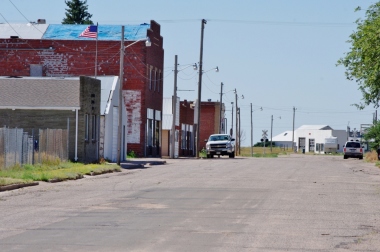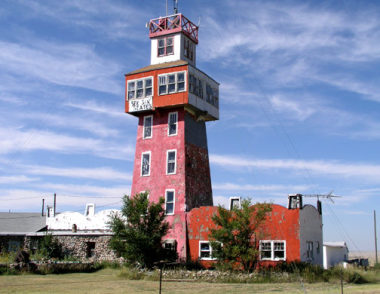Genoa – Colorado Ghost Town?
by local author & historian: John LaBorde
As the Chicago Kansas Nebraska and Colorado Railroads continued building westward, they came to the pinnacle of Genoa. This was advertised as the highest point between Kansas City and Denver. Out on the escarpment one could look forever, well so it seemed. To the west rose the majesty of Pikes Peak, below was the broad expanse of the Big Sandy valley, and all round spread the short grass prairie. The view was unsurpassed. It seemed there was no limit on what one could see from on top of the world here.
Railroad workers paused on the ridge to take in the view. Below them the railroad was putting in a siding at a place called Creech.
Creech was the name of a Rock Island executive. A boxcar was placed at the west end of the flats for a depot. Soon there was a town platted out and businesses were established.
Creech was not a popular name for the new town and it was replaced by Cable. The popularity of Cable was even less. When the town folks heard that a railroad worker was hurt in an accident and was dying, Cable became short lived. The railroad worker was from Italy and he told his fellow workers he didn’t want to die here, he wanted to go home and be in his home town of Genoa, Italy. To honor the dying man the town name of Cable was changed to Genoa. The name stuck and has survived a century.
Settlers were moving in and homesteading. The new town of Genoa grew and prospered, a bank, newspaper, grocery stores, hotels, blacksmith, boarding houses, hardware, moving picture house, and gas stations were built. The railroad was busy with the new little town – named after the hometown of a worker.
With the advent of the horseless carriage a new American tradition popped up, the roadside attraction. This ridge with the great view was also a bane for the early American automobile traveler. Up and down the Genoa hills the puddle jumpers would struggle often overheating when they got to the top of the hill. So an entrepreneur set up shop at the top of the last hill. Here travelers could pull in and service their struggling car and maybe spend some money. A tower was erected that advertised six states could be seen from the top. Genoa was now on the map with its own tourist trap.
Today the Tower is temporarily closed but Genoa has rolled up its sidewalks. There is a Post Office, a grain elevator, and a town hall that is open part time. Walking down the street one notices the hotel is shuttered, the bank is now a residence, the tractor store is falling down, the drug store/grocery is in jeopdary of collapse, and there are numerous abandoned buildings in town.

Life in the small town was different in days past. Not entirely a ghost town today, but Genoa is a far cry from its heydays of the early 1900s.

